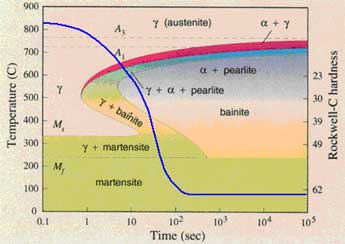 |
|
| Quenching |
|
Pay special attention to the area in the picture labeled ‘Precipitate’. Since many of the carbon atoms have precipitated out and collected in this area, this would be considered a defect in the steel. Quenching Just as phase transformation takes place during the heating of steel, it also takes place during the quenching or cooling process. Quenching can be used to increase the hardness of steel. At high temperatures, alloying metals are completely dissolved in the base metal, so quenching traps the alloying metals within the crystal structure and does not allow them to precipitate out separately.
|


 Many
methods for quenching exist, including: cooling in air, water,
oil, and salt. The type of cooling process used helps to determine
how fast or how slowly the steel cools. Ultimately, the rate of
cooling helps determine many of the important characteristics of the
steel.
Many
methods for quenching exist, including: cooling in air, water,
oil, and salt. The type of cooling process used helps to determine
how fast or how slowly the steel cools. Ultimately, the rate of
cooling helps determine many of the important characteristics of the
steel.